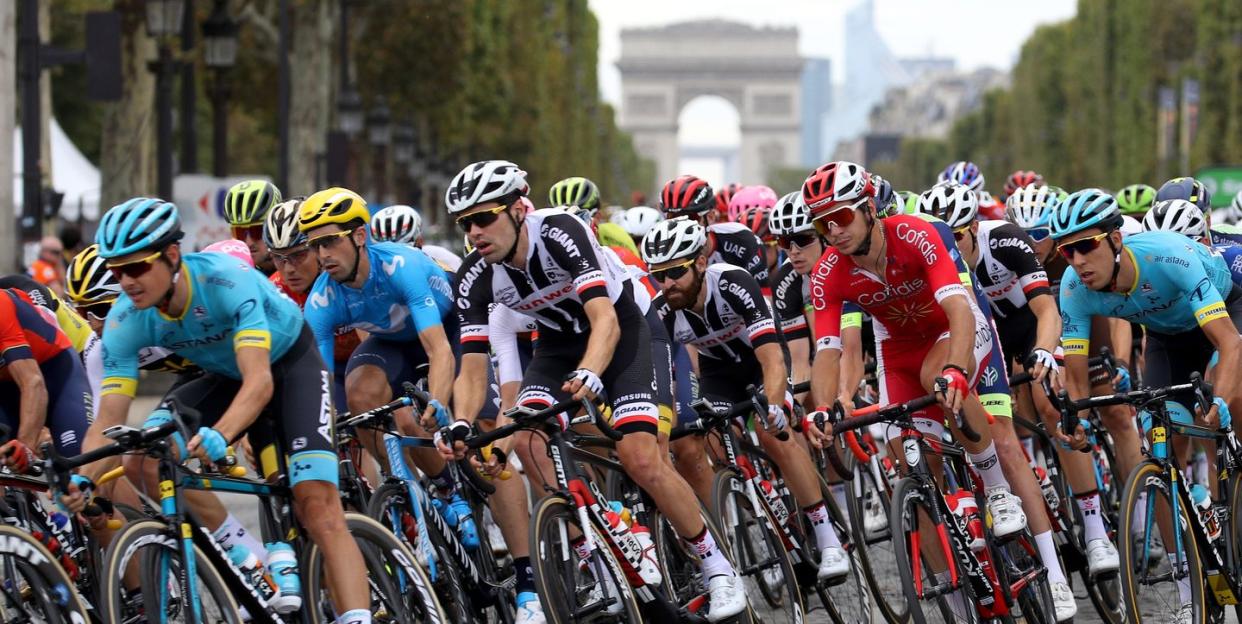The Key to Max Human Endurance Might Actually Be in Your Gut

According to a study published in the journal Science Advances, humans can only go for so long before they hit a limit of exertion.
This is because your digestive tract can only absorb 2.5 times your BMR’s (basal metabolic rate) worth of calories per day.
Your body can’t use any calories ingested past that point, so your performance will dip.
With the recent wrap-up of the Tour de France, it’s natural for us to be in awe of the amount of endurance the riders all must have in order to complete the 23-day long, 2,200-mile race.
But when it comes to physical activities that require athletes to sustain performance over a long period of time—like the Tour—new research shows that humans can only go for so long before they hit a limit of exertion. And the reason for that blockade might have to do with your gut.
In the study, published in the journal Science Advances, researchers looked at how many calories per day athletes who ran a the 3,000-mile Race Across the USA burned, as well as other endurance races like 100-mile trail races, the Tour de France, and a 95-day Antarctic trekker.
Their findings? While everyone starts burning calories at a high level, the amount levels off at 2.5 times your BMR’s worth of calories per day. BMR refers to your basal metabolic rate, which is the rate at which you burn calories when you’re completely at rest, according to study coauthor Herman Pontzer, Ph.D., associate professor of evolutionary anthropology at Duke University.
You can burn calories faster than that—Tour de France cyclists burn 4 to 5 times their BMR during the race for example, Pontzer explained. But your digestive tract can only absorb 2.5 times your BMR’s worth of calories per day.
“Think of it like a bank account. The money in the bank is your energy stores—your fat and glycogen. You ‘spend’ that energy each day, and then put it back into your account with the food you eat. There’s a limit to how fast you can put the money back in. So spending calories above 2.5 times your BMR isn’t truly sustainable—your body runs a deficit. You can do that for a while, but not forever,” he told Bicycling. This means that while you may be burning more calories at the beginning of these types of events, everything levels off eventually.
Fueling is extremely important to keep you going through any endurance event—according to the American College of Sports Medicine, you should consume 30 to 60 grams of carbohydrates per hour of exercise if you’re exercising for longer than an hour. Additionally, consuming electrolytes such as sodium should also be consumed if you’re exercising for longer than an hour.
But since our bodies can’t absorb any more nutrients past a certain point, if even you did eat more food during a long, grueling race, the calories ingested past that limit would go to waste, Pontzer said.
“GI issues are likely, but more likely, the person would just feel unable to keep eating—if you’ve ever tried to force yourself to eat when you are totally full and satiated, you know how this can feel,” he said.
[Find 52 weeks of tips and motivation, with space to fill in your mileage and favorite routes, with the Bicycling Training Journal.]
Because of this, there comes a point where it’s impossible for humans break records, because they can’t absorb enough nutrients to fuel their bodies after a certain point—and as we all know, if you don’t get the fuel you need, your performance could take a nosedive.
“The limits of long-term endurance—days, weeks, and months—are non-negotiable and seem to be set by your body’s ability to take in calories,” Pontzer said. “And the limits are dependent on time frame. Just as you can sprint for only a few seconds but can sustain a slower pace for longer, we can maintain high expenditures for a day or so, somewhat lower expenditures for a week or two, and the limit for longer events is lower still.”
You Might Also Like

